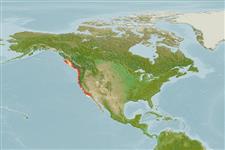Environment: milieu / climate zone / depth range / distribution range
Ecology
Marine; demersal; depth range 84 - 368 m (Ref. 51666). Temperate; 55°N - 32°N
Eastern Pacific: British Columbia, Canada to San Diego in California, USA.
Size / Weight / Age
Maturity: Lm ? range ? - ? cm
Max length : 13.0 cm TL male/unsexed; (Ref. 2850)
Short description
Identification keys | Morphology | Morphometrics
Dorsal spines (total): 55 - 57; Dorsal soft rays (total): 0; Anal spines: 2; Anal soft rays: 34 - 35. Caudal rounded; lower 6 rays of pectorals elongated (Ref. 6885). Dusky olive brown dorsally, paler below; about 25 vertical light bars, narrower than intervening spaces, about 3 vague dark blotches spaced along side imposed on other pattern; dorsal fin with oblique dark bars, some intensified to make black blotches, especially toward posterior end; caudal, anal and pectoral fins with dark bars parallel to edge leaving a pale margin; sometimes a dark spot on inner dorsal margin of caudal fin; pelvic fins without markings (Ref. 6885).
Inhabits gravel and sand bottom (Ref. 51666).
Life cycle and mating behavior
Maturities | Reproduction | Spawnings | Egg(s) | Fecundities | Larvae
Eschmeyer, W.N., E.S. Herald and H. Hammann, 1983. A field guide to Pacific coast fishes of North America. Boston (MA, USA): Houghton Mifflin Company. xii+336 p. (Ref. 2850)
IUCN Red List Status (Ref. 130435)
Threat to humans
Harmless
Human uses
Tools
Special reports
Download XML
Internet sources
Estimates based on models
Preferred temperature (Ref.
123201): 6.3 - 8.8, mean 7.3 °C (based on 34 cells).
Phylogenetic diversity index (Ref.
82804): PD
50 = 1.0000 [Uniqueness, from 0.5 = low to 2.0 = high].
Bayesian length-weight: a=0.00389 (0.00180 - 0.00842), b=3.12 (2.94 - 3.30), in cm total length, based on all LWR estimates for this body shape (Ref.
93245).
Trophic level (Ref.
69278): 3.2 ±0.5 se; based on size and trophs of closest relatives
Fishing Vulnerability (Ref.
59153): Low vulnerability (10 of 100).
